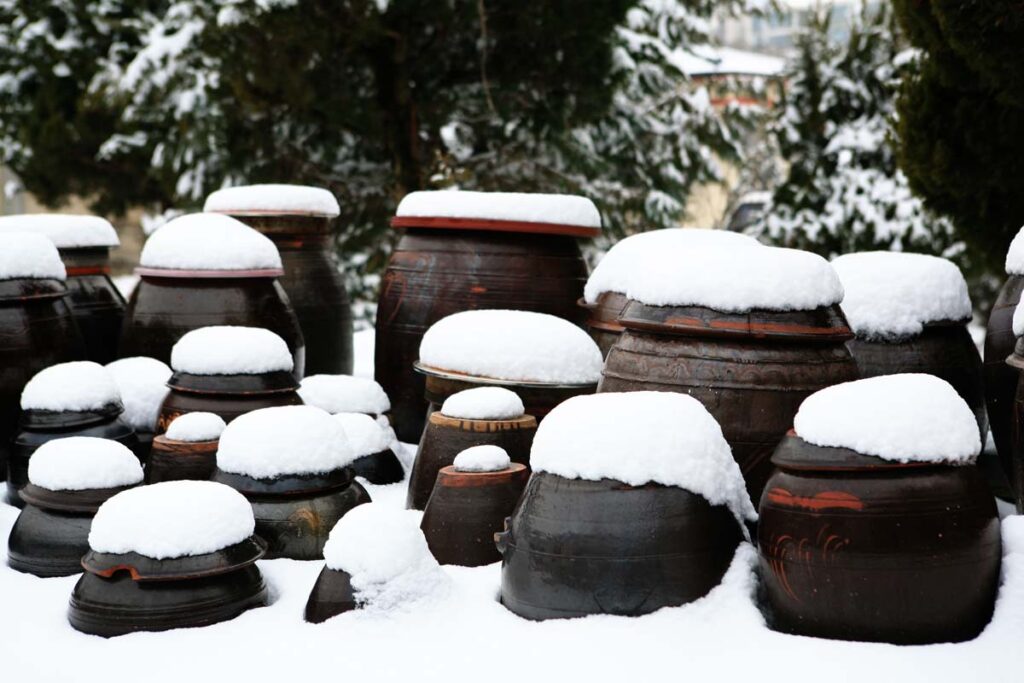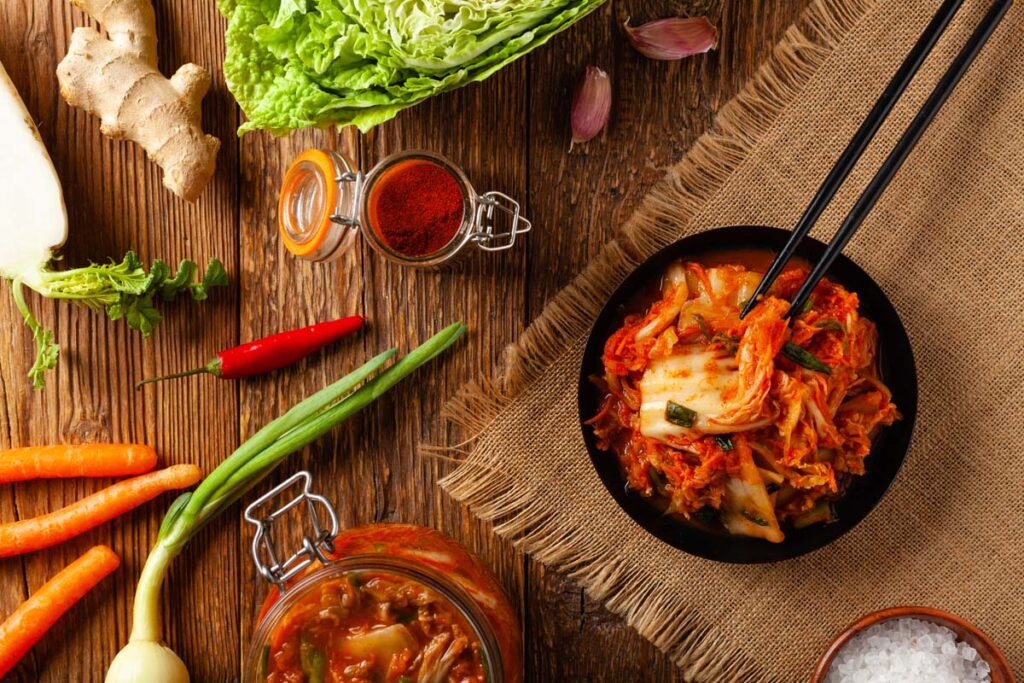*Click here to directly go to the recipe for Kimchi.
Benefits of Kimchi
You might have heard about the benefits of kimchi. It contains lots of vitamin C, vitamin A, and various minerals. It improves immunity, controls cholesterol and slows down the aging process. Koreans eat kimchi a lot. One research said that one person consumes 80 lbs. of kimchi every year in South Korea.
Making Kimchi As a Preparation for the Winter
When I was young, we didn’t have a refrigerator at home and kimchi was a major source of vitamins and minerals in our diet during the winter time. So, making kimchi was one of the most important winter preparations.
After the harvest in autumn, ladies in the village gathered together to make kimchi. What they did was to gather at one of their houses and made kimchi for the house all day long. They usually used 60 to 100 Napa cabbages for one house depending on the number of the family members. And the next day, they visited the next house and did the same thing. They repeated it until all the members had their share of kimchi. Back then the clay jars worked as kimchi refrigerators, so they stored kimchi in the clay jars during the winter.
When the children saw piles of cabbages here and there in the village, that meant that the winter was coming and that kimchi was being prepared.

The main chefs are microorganisms and you are just a sous-chef.
After I grew up and left my hometown, it was hard to find the same taste of kimchi from my hometown. Many Koreans miss their hometown Kimchi. That’s why in order for the Korean restaurants to succeed in Korea or in Korean towns, they should provide the best kimchi and rice.
Many years ago, I was running a program for sustainable living in Arizona. At the time, I made kimchi with my students together and one of the students named Patricia filmed how we made kimchi. She summarize it as a 5-minute video. But, that doesn’t mean you can make kimchi within 5 minutes.
After preparing ingredients, it will take about 4 hours to soak cabbages with salt water. While soaking cabbages, you can prepare kimchi paste. And, after putting kimchi paste on each leaf of cabbages, you need to leave it at room temperature overnight. Then, you can eat it the next day.
When you make kimchi, remember that you are just a sous-chef. The main chefs are microorganisms, and what you do is to prepare the best conditions, so the main chefs will do their best job overnight.

Where to Find Ingredients for Kimchi
I’m sure you will be able to find most of the ingredients to make kimchi in your local grocery markets. They are Napa cabbage, pepper, garlic, ginger, radish, green onion, pear. Yet, there are a few ingredients that you need to visit Asian section or Korean market. They are pepper powder, fish sauce, sweet rice powder. If you can’t find them in your local area, you can even order on Amazon. Pepper power is called Go-chu-gah-ru in Korean. Alexa, add Go-chu-gah-ru in our shopping list.


Step By Step Recipe for Kimchi
Things you will need:
- knife
- cutting board
- blender or mixer
- 1 large Tupperware and 1 small Tupperware
- colander
Ingredients you will need:
- cabbage
- green Korean pepper or Mexican chili jalapeno
- garlic
- ginger
- radish
- onion
- green onion
- pear
- coarse sea salt
- 5 spoons of sweet rice powder
- Korean anchovy sauce or fish sauce
- Korean red pepper powder or chili powder
- table salt
- honey
Step1. Soaking the Cabbage
- Mix 2 cups of sea salt with 2 liter water.
- Cut the 4 cabbage into quarters.
- Soak the cabbage in the salt water for 5 minutes.
- Take out the cabbage and put salt in between the leaves.
- Place the salted cabbage in the large bin.
- Pour the used salt water in the bin.
- Leave the cabbage for 4 hours.
4 hours later …
- Rinse out the salt in the cabbage.
- Place the cabbage facing down in colander to dry.
Step2. Making Kimchi Paste
*It’s made for 4 cabbages. If you’re using 2 cabbages, use a half of the amount.
Make Sweet Rice Paste.
- Put 2 1/2 cups of water in a pot and heat it.
- Put 5 spoons of sweet rice powder.
- Stir as it’s heated.
- When it starts boiling, stir it for 2 more minutes.
- Take it off the burner.
Prepare Vegetables for Kimchi Paste.
- Cut off the roots of green onions.
- Cut the white ends of green onions and put them in blender.
- Cut half of an onion and put it in blender.
- Put about 20 pieces of garlic in blender. (Use less or more as desired)
- Put 2 bulbs of ginger in blender. (Use less or more as desired)
- Put 4 peppers in blender. (Use less or more as desired)
- Put half of the radish.
- Peel pear and put it in blender.
Blend Kimchi Paste.
- Add a cup of fish sauce (or Korean Anchovy sauce) in blender.
- Blend all the ingredients.
- Stop the blend and add the sweet rice paste in blender.
- Blend again.
- Pour the paste in a bowl.
- Add 2 1/2 cups of pepper powder in the bowl and mix thoroughly. (Use less or more pepper powder as desired)
- Add 2 spoons of honey and 2 spoons of table salt.
- Cut the green parts of green onions into 2 inches and put them in the bowl.
- Mix them. Your Kimchi Paste is done.
Step3. Spreading Paste
- Spread the kimchi paste on the bottom of a large container.
- Spread the kimchi paste in between leaves of the cabbage.
- Place the cabbage in the big container.
- Leave the container at a room temperature for one day.
- Next day, take out one piece of cabbage.
- Cut it to desired size. You can eat it now.
- Store the cut kimchi in a separate container and keep it in a refrigerator.
- Keep the large container in a room temperature for 2 more days. After that, you need to store it in a refrigerator.
- Whenever you finish the cut kimchi, you can take out another piece from the large container and cut it to eat.
Any Questions?
While you make kimchi, if you have any questions, please contact me at shawnslee.com/contact. Thank you and see you next time.



